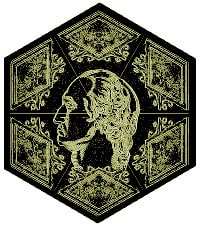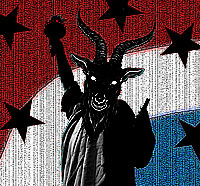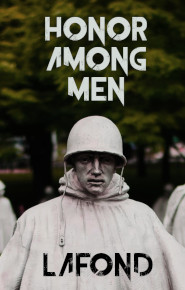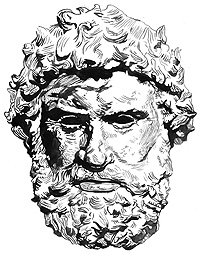On Battle
According to Alexander, no greater truth about war was part of human memory than Homer’s Iliad. Modern historians scoff at this notion, as if “he who was first in the profession of arms” in all of history knew nothing of his vocation. What the Iliad tells us is the same thing that Xenophon tells us in the Hellenica and Anabasis.
Fortunes of Battle
Slings and arrows and hurled spears represent the malicious and even random peril of battle, ever present and taking men regardless of merit, to include Achilles. Many times a hero misses his spear cast and a man behind or beside the target is slain at random.
King of Battle
The spear and shield together impose will upon battle, the spear king of battle, deciding the day, standing against the tides of battle like a breakwater and breaking the enemy like a storm breaks a dyke. See Gilgamesh Book 1.
Queen of Battle
The sword, and her crude analogue the ax, are the tools of the executioner, the weapons of death. These were used mostly to slaughter foes broken by the spear, to slay captives “put to the sword.” The main use of the cavalry saber from 1618 through 1815 was the slaughter of fleeing footmen. Achilles used the sword to slaughter fleeing men and the 12 captive Trojan youth at the funeral pyre of Patroclus. The American frontier term was “war to the knife” or to “take up the hatchet” to kill. Thucydides account of the Syracuse expedition, the use of the ax and sword as executioner’s tools across ages, cultures and faiths, and the symbol of the Roman fascines, an executioner’s ax bundled in rods of punishment, make this clear. Hence, the sword and ax, particularly as weapons of the siege and sack of cities, were objects of terror to the low morale slave soldier of the majority of armies of Antiquity. See Burton’s Book of the Sword.
Attacking and resisting are the imposition of will on the enemy. Wiles are the minimizing of losses and the maintenance of the soldiers’ ability to impose his leader’s will through confidence in the commander.
It is strange that a non Macedonian unit was cited for combat honors more often by the heroic Macedonian conqueror than even his guards. The reasons are clear in Arrian’s narrative when he says, “All returned to camp safe and sound,” after the Getae battle and with “least loss of life,” describing the attack on Thracian positions at Mount Hiameus Pass. Alexander, his companions and guards might have a heroic temper. But most of the army were working on short pay and did not wish to suffer the fate of Patroclus, Hector, Achilles or Ajax, and, as well dreaded the idea of not returning home. These were not modern Americans bred to tolerate migration of home every decade of life, but traditional people who could only ever have one home. Alexander KNEW he was headed off for good and had to come up with a recipe for keeping men charged up for the next adventure by a combination of success and light casualties.
Hence, the Agrianes and archers, led by adventurous brigadier generals from other nations, nations that were highly afflicted by the international banking interests backing the Persian empire, [1] were perfect units for leading off. Light units attacking was a novel idea for everybody, granting social shock value against the most effective enemy units: Persian aristocrats and Greek traitors. It also challenged the honor of the Guards and Companions who would want to out-do these light troops. [2]
…
How were these men armed?
Historians have the idea that the Agrianes were simply peltasts, same as Thracians, which makes no sense, since they always burned through their light counterparts as if they were not there, attacked heavy formations head on and fought toe-to-toe with barbarian medium infantry. Historians reject the idea of ancient medium infantry. Yet these existed in the form of Iphicrates reformed Hoplites from the previous generation, about the 370s when Phillip was captive at Thebes and scheming the creation of the Macedonian army. These used smaller shields, lighter body armor and possibly javelins. The defeat of the Spartans on Sphiactra in 404 showed that peltasts could defeat hoplites if used aggressively.
It is obvious from Arrian that Longarus, the Agriane King, who was a kind of war uncle to Alexander, had various grades of troops. Also, his neighbors and foes, the Tarlantians, who also lived in the mountains, had horsemen, heavy hoplites and light troops, apparently of various types. Such tribal units would tend to mix slingers and archers as specialists among the more common javelin and dart throwers. Throwing light spears and heavy darts was the regional method of war at a distance from Homer’s time down to the 300s and 400s A.D. But, archery, depicted as useful for Odysseus, lord of forested-mountain Ithaca, was a necessary form of hunting, and slinging stones an economic activity for the mountain herders that made up the population base of the highlands.
Armor, though hoplites trained to run in it over short distances, was out of the question except for officers and Guards of the Agriane. Most archers would be hired out to the Macedonian archer brigade. [3]
How did Phillip and Alexander become such good commanders of light troops?
Theirs was a front-tier kingdom.
French and English Americans from Champlain in the 1600s, down to Church in the 1670s, Rogers in the 1740s and 50s, and Howe and Cornwalis in the 1770s and 80s, learned light infantry tactics in forested mountains the hard way, from the native enemy, in alliance with the native enemies of their enemy. Modern infantry tactics are based on this, successfully used in Spain from 1806 to 1809 by English against French, and later used to develop “storm trooper” tactics by Ernst Junger and Erwin Rommel in WWI, which relied on infiltration, and night fighting and was called, “fighting in Indian file.”
The Agrianes and Archers were the Macedonian rangers and special forces and worked together in the same fashion, with the Agrianes the rallying force for the archers, who they rescued a few times at Pellium, Thebes and in Phrygia in Book 2 of Arrian.
Their methods will be the subject of the series of novels in The Areid, beginning with Grace: Book 1.
In search of a more recent analogy, in Early Modern America, how did tribesmen bedevil heavier-armed troops in forested mountains very similar to the Agriane, Thracian, Triballian, Illyrian frontiers and the mountainous regions of Asia, from Phrygia, to Kurdistan to Afghanistan?
The basic hunting/raiding file was of three men. This was standard from the Shawnee of the east to the Apache and Pawnee of the west.
The Cherokee, who had the greatest mix of Native and European/American enemies, fought in a file of five, three-facing skirmish line with a back-up man and flanker.
The basic arms of the region were:
Primary
-long gun
Secondary
-hatchet/tomahawk
-knife
Special
-War club/sword, [4] weapon of a notable chief or hero
-Lance, wielded by specially sworn warriors, such as the white Indian that rampaged around Fort Wheeling and later Cheyenne Dog Soldiers. [5]
-Bow & arrows, every 5th Cherokee warrior, the leader, was armed with a bow to protect against and exploit overruns when guns were empty.
Shields had been discarded due to firearms blowing through them.
…
As Ancient analogues, the Agriane arms would be:
Primary
-Shield & Darts [small javelins] used together of necessity, so as not to expose the armpit while casting. The shield would be a small, light figure of 8 with a strap for wearing on the back, and a hand grip, facilitating punching even as the central cutout over the elbow permitted casting and sighting. The function of the empty long gone as a clubbing tool would be filled by the shield, the fear of the musket shot by the probably 5 darts. Modern historians assume these were the only weapons of the peltast, which ignores Arrian, Iphicrates and analogous combat sense. Thracian and other peltast shields were shaped like a half moon and protected the arm pit less while throwing and were marginal for punching.
Secondary
-Light war axes, like the hatchet/tomahawk are useful camp tools, cheap, easily repaired, and aid in siege work, dragging horseman out of the saddle and climbing cliffs and trees. These are even better with the shield then with the knife of the American frontier.
-Machera [machetes] would also replace war axes among some warriors, when they could be had and when practical. Ideally, every second man, that is 2 of 5, would have the machete, with 3 of 5 armed with an ax for stripping shields and pulling down riders. The machete would be better while defending and night fighting, the ax while attacking in main encounters by day, both of complimentary value in siege work. The mix of these two weapons would be like the mix of U.S. GI firearms in WWII, carbines and rifles in the same unit for operational flexibility.
-Knives, small to large knives would be carried by all such troops. How else would they provide their animal skin shield covers, boots [more like moccasins], leggings, ponchos and cowls? The WWII analogy would be the 0.45 APC.
Special
-Swords would replace war clubs, the WWII analogy being the Thompson submachinegun for close range mayhem.
-The lance would be the lance, wielded by a file commander armed with a larger shield as a rallying point. This man would also be armed with darts as well, be bigger and stronger than normal, and possibly be throwing full size javelins as a result. Despite lack of body armor, he is a heavy footman. I suggest light Iphicratic type body armor for this man. [6] His presence is the best explanation for why “the Agrianes yielded nothing” in battle. The very accurate WWII analogy would be the B.A.R. operator. The Legions of Republican Rome, who depended on hurled javelins, used this strategy, with the triaria, third line fighters, using spears.
-The bow or sling would be employed to compensate for the easily depleted darts and provide firing cover in retreat and for exploitation. The darts are 5 times heavier than arrows, and would not last long, with all five thrown easily within 30 seconds. While more darts are run up front by boys or the retreat is conducted, an archer or slinger could provide covering fire, having much more ammunition. Also, a thrower’s shoulder wears out over age. The sling and the bow can be plied to an advanced age even with injured shoulders. Therefore, older veterans with blown shoulders might be retired to second line duty. This is similar to the Roman triaria model. The WWII analogy is the light machine gun, the Bren or the MG34.
As to how these moving parts of the most cited unit in Ancient warfare functioned, is the subject of the Areid novels.
…
Notes
-1. The Agrianes and other small Balkan nations had agents among them paying off second rate chiefs to compromise the rule of the kings and princes in favor of economic exploitation by alien slave drivers. The bankers of Babylon either paid for the right to import slaves to mine gold or for local lower class people to be enslaved to mine gold. Corruption of tribal leadership by imperial bribes was not a Roman or American invention. The people of Crete were not subjugated by the Persian navy. Their rivals of Rhodes were Persian vassals and provided an advance naval base for the Persian fleets. The conquest of Persia by Alexander would free Crete from a looming naval threat. So, the Agrianes and Cretan “mercenaries” were motivated by love of country and were highly effective in service to a larger nation battling an even greater one. The modern parallel would be the very motivated and effective service rendered by Hungarian, Cossack, Romanian and Italian military units again the Soviets Red Army in WWII.
-2. After the death of the Cretan commander, Eurybotus at Thebes, command of the Archers was regarded as an honorable appointment for a Macedonian officer.
-3. For unit size my reference is the Black Powder Era, including the Civil War, which had lesser men in the same designation than today. A file would be a team or squad. A company or band varied from 2 or more squads, as few as 30 to as many as 300 men, as would a troop of horse. A battalion is reckoned at 400 to 800 men. A brigade is roughly 1000 to 1200 men, the archers and Agrianes being 1000, later reduced to 500 by detachment, and the phallanx taxilla about 1200. Divisions are references to larger national contingents, mostly in the Persian service, ranging from 1,000 to 10,000.
-4. When they were available, native warriors liked swords, called “long knives” or “shemanese” for which they named the invading officer class.
-5. See Messach Browning and Zane Gray’s novel of Lewis Wetzel.
-6. A quilted vest, perhaps with a groin skirt, sewn with some studs, bands or plates, similar to the jack worn by musketeers and pikemen of the powder and shot era of the late 1500s and through the late 1600s.











